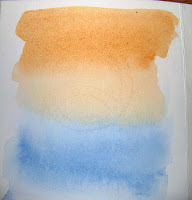Today we will look at the circle as a tool to help us mentally focus...
 |
| Circles on my grocery list so I am SURE to get those items... |
Circles as a way to narrow our attention, or draw it towards a certain point, is so common, so instinctive, that we may not even consider the act of circling as a tool to help us work through strong emotions, calm a feeling of anxiety or as a way to diffuse racing thoughts. For example, I am a note taker - I take notes
in the books I am reading; I continue to use spiral notebooks to record my own thoughts and the quotes and instructions I want to especially remember from the books I read. And to help me find, once again, the really good things - I circle them...sometimes the line is more
rectangular, but still I have encircled the portion I want to be able to find again - and that serves as a way to draw my attention, my focus, to that portion I know I will be coming back to.
So - it could be said that circles can be used to help remember, recognize, and reorder!
Let’s move into some exercises using circles to help one focus:
1.
Exercise one: Recognizing importance – using circles to
relieve anxiety over being over-scheduled:
using paper and pen/pencil, make a list of all the things you need to attend
to on the next day. Try to limit what
you write to just a word or a short phrase, for instance: laundry, dr. apt. at
2 pm, call _____, order ______, etc. Also, try to get the day’s list finished
within five minutes. Write as fast as
you can, not worrying about spelling or punctuation. At the end of five minutes (or sooner) go
back through the list and circle the 5 that have the highest importance and
then number those 5 in order of importance.
Do not overthink this and do not spend more than another 5 minutes on
this part of the exercise. You may
not finish your entire list on the next day, but if you focus on your top 5,
you will most probably accomplish them, and have the satisfaction This is a
great way to prioritize items that do not already have a set time and to
quickly relieve a sense of overwhelm or anxiety about “having too much to do”. You can adopt this principle for other issues
that are causing anxiety for you.
2.
Exercise two: Reordering scattered or racing
thoughts/emotions – Does just reading those last four underlined words make
your stomach do a little flip flop? Did
you brain just go…somewhere? Many of our
“normal” days can be so high stress that just thinking or imagining more stress
or chaos can send us there! So this
exercise will be a great one to put in your toolbox of self-calming tools – and…it
can be done anywhere, at the office, waiting for children at soccer practice,
watching TV with the family, even in your quiet time if needed. Draw a four to six inch circle on a piece of paper you have
handy. This becomes a container for those ambiguous feelings
or racing thoughts. Now, within the
circle, color or doodle…there is no right or wrong here. But just to get you started, consider:
 |
| Miss Sweet Tweener was a little heavy with the color! |
Color concentric rings, starting at the line you drew and working towards
the center.
Divide the circle into parts using straight lines,
 |
| You could even doodle or write over the watercolor or colored pencil... |
Make large "scribble" lines, then color each space or doodle in each space.
Draw, color, or paint an image of a peaceful place (to you) within the boundary of the circle.
Write words that you need to be peaceful within the circle, or
write just one word that calms you and embellish it with designs and/or color.
When you finish, note how you are feeling - emotionally. Write down how you feel someplace near your circle. Note any clarity, new ideas, or creative solutions to problems you have been having as well.
3.
Exercise three - a) circles as simple containers for memories or b) temporary containers for racing or intrusive thoughts - Use this little exercise (really another form of exercise 2) to quickly capture the events of a day or to dump racing thoughts.
a) Draw a circle an inch or two in diameter, then draw an image
or write a word or two describing something you want to remember. The act of making the circle narrows the mind's focus, and the most important events are what emerge in the forefront of your thinking...making it simpler to choose which events to record! Don't forget to date your page...
 |
| A little watercolor wash behind my brief journaling circles. |
b) In the case of racing or intrusive thoughts, write enough words to capture the thought, using one circle for each thought. Do this for as many thoughts as needed. It is OK to write outside the lines! Notice how the circles act as a containment vessel for the thought, and that the feeling of calm increases as each thought is expressed and contained. You might even consider folding this paper in half and tucking it in a safe place as a metaphor that you are tucking these thoughts away
in a safe place in your mind until there is a good time to continue processing them. Sometimes just the expression is all that is needed to diffuse troubling thinking; sometimes more processing is needed.
This is a tool to bring control and calm and containment till a more convenient time to address the thoughts, not to bury toxic thoughts indefinitely (which would be unhealthy).
Also, in using art for healing, one isn't necessarily trying to produce an art masterpiece, but a heArt masterpiece, so "proper" art technique isn't as important as the process itself. This is the time to "let go", experiment, and relax!
Linking with my "In the Studio" friends again...here...


























